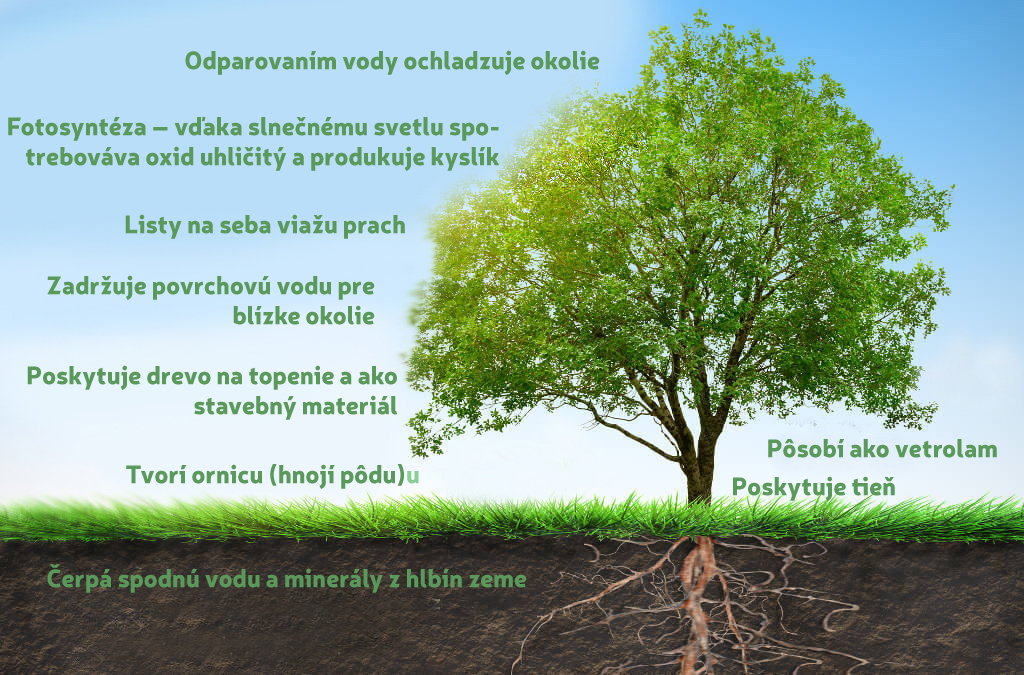Stromy sú základný kameň života na zemi
Do you know how the trees affect our life and what they do? One might think of oxygen production, timber production, for building material or heating. There are other ways the trees affect our life and surroundings.
Producing oxygen, capturing dust, removing carbon oxide (CO2)
We all know that trees produce oxygen. The internet site www.arnika.org states that an adult tree is able to provide oxygen for 10 people. Average temperate deciduous forest the size of which is one hectare produces around 10 tons of oxygen. Such an amount of oxygen for the same period of time “feeds the lungs” of around 38 people.
In addition to producing oxygen, the tree is able to capture dust and remove carbon oxide from the air. The forest growing on an area of one hectare is able to absorb and remove around 15 tons of carbon oxide from the air every year. To make a comparison – according to an this article, a man weighing 70 kg produces 240 kg of carbon oxide per year and a modern man (including cars, houses, etc.) produces 2.3 tons of carbon oxide per year. You can see the difference between the amount of carbon oxide that a human body produces and the amount a human being produces because of its life standard. Is it not true that we should plant more trees as the technical and economic progress increases? Unfortunately, nowadays the situation is the right opposite. Because of growing progress, we cut off yet more forests to cover the needs of a human being.
The trees capture dust, hence clean the air. Beside carbon oxide, the trees capture dust without man’s effort. A tree for growing needs just a piece of land and underground water. Moreover, some wood species release phytoncides into the air (natural antibiotic) which kills disease-producing bacteria.
Warmth, shadow and windbreaker
When taking a walk, have you ever realized that it is a bit colder in the forest during the summer and a bit warmer during the winter? Once again, it is because of the trees!
Through evaporation (underground water – roots – leaves – vapours), the trees cool the air. An adult tree evaporates around 400 litres of water per day, hence it constantly cools the air and enhances natural circulation of water in nature. Besides water evaporation, a deciduous tree at the edge of a forest, garden or park serves as a windbreaker, and therefore, it feels so nice in the forest. As we know, tall trees provide shade in which we all love to hide.
Last but not least, the wood from trees has been for thousands of years used as a building material and for heating. Nowadays we know how to mine coal, which was just wood a million years ago.
Trees enhance production of quality soil
Trees enhance the formation of upper layer of soil, called the topsoil. Especially with leaves which pile under the tree throughout its life.
The places where trees were standing before are now turned to fields. The question is, how can we get the arable soil that takes millions of years to be created? The modern agriculture will cause its reduction in a few decades. Besides reducing the fertility of soil as a result of modern agriculture, farmers use more and more artificial fertilizers.
Retention of water in a country
Trees do have significant effects on the circulation of water, but also on the retention of water in a country. They enhance the circulation of water through roots which absorb underground water, evaporating it later on. Trees are basically like natural pumps. In addition to water, roots absorb also nutrients from the soil. The trees then evaporate water, absorb nutrients to enhance the growth of leaves, branches and other parts which once again help creating the topsoil after they have fallen down. Because of the shade they provide, because of roots and reduction of the wind blowing, the trees help retain and preserve upper water near the tree, hence prevent water erosion.
Reduction of noise
Another positive effect the tree and shrubs offer is the reduction of noise. According to an article at biom.cz, a green alley that is 3 meters wide reduces noise by 25 per cent in the built-up areas and streets. Whether the noise reduction is effective depends on how wide and how dense the green alley – grass, shrubs, trees is – all this helps.
What would happen if there are no trees?
– Production of oxygen would decrease significantly, because the main source of oxygen on Earth is photosynthesis.
– Content of carbon oxide would increase because trees would stop absorbing it.
– The amount of dust in the air would grow.
– Winds would blow more.
– The circulation of water in nature would be disturbed, around 10 per cent of moisture in the air is formed thanks to plant evaporation.
– The soil would erode much faster.
– The temperature in the air that was cooled by trees would increase.
Author: Radek Kučera from a non-profit organization Náš svet. Náš život is a movement with the aim to promote the local independence of families, the sustainability of using up natural resources and the increase of responsibility that the individual and companies have on environment. The article is taken from the internet site: www.naszivot.cz/stromy.


